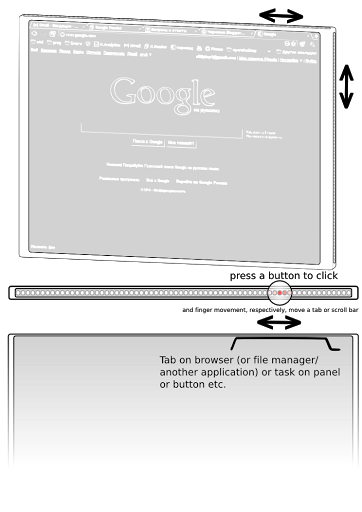The concept of touch control on the tablet
In Google Chrome, the tabs are located on the top for the reason of convenience: you can move the cursor right up to the edge of the screen, without particularly aiming, and move or switch the tab. For the same reason, longer displays of running applications on the taskbar are convenient. On tablet netbooks, on the one hand, the sense in such interface functions disappears, but the constant presence of hands or stylus on the screen distracts.
The meaning of the concept lies in the fact that along the edges of some tablet netbook are touch stripes for the reaction of adjacent interface elements (tabs, scroll bar, running applications, buttons .., i.e., anything adjacent to the corresponding edge).
Accordingly, when you move them with your fingers most likely, the tab or the position of the scroll bar moves, the application starts up on the corresponding icon, etc., here’s an example of this:

In the course of some discussions, the concept itself was slightly modified: for activation, i.e. a click you have to click a little on the bar in the appropriate place, after which scrolling / moving tabs simply by moving your finger along the bar works. This approach is more convenient for both clicking (highlighting something or launching an icon from the side) and prevents accidental pressing while holding the tablet.
In fact, the idea was pushed by the existing camera samsung nv10 with similar controls, which is much more convenient than the touch screen of the camera. Although the concept of a touchscreen (or in some other way responsive to pressing) screen is not excluded, the innovation simply comes as an addition to it (although it is possible that in some cases it can serve as a replacement, for example in electronic books).
Published at the request of the author
The meaning of the concept lies in the fact that along the edges of some tablet netbook are touch stripes for the reaction of adjacent interface elements (tabs, scroll bar, running applications, buttons .., i.e., anything adjacent to the corresponding edge).
Accordingly, when you move them with your fingers most likely, the tab or the position of the scroll bar moves, the application starts up on the corresponding icon, etc., here’s an example of this:

In the course of some discussions, the concept itself was slightly modified: for activation, i.e. a click you have to click a little on the bar in the appropriate place, after which scrolling / moving tabs simply by moving your finger along the bar works. This approach is more convenient for both clicking (highlighting something or launching an icon from the side) and prevents accidental pressing while holding the tablet.
In fact, the idea was pushed by the existing camera samsung nv10 with similar controls, which is much more convenient than the touch screen of the camera. Although the concept of a touchscreen (or in some other way responsive to pressing) screen is not excluded, the innovation simply comes as an addition to it (although it is possible that in some cases it can serve as a replacement, for example in electronic books).
Published at the request of the author
')
Source: https://habr.com/ru/post/110253/
All Articles